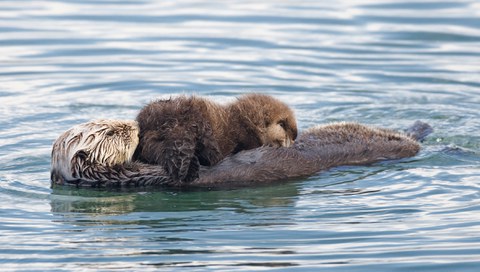Feb 27, 2023
Animals and Money: Sea otters, Sea Urchins and Climate Change - The Importance of Kelp Forests

Sea otters play an important role for the kelp forest ecosystem and also benefit the economy.
North America’s kelp forests are habitat to many economically important species, sequester atmospheric carbon dioxide, nourish huge ocean areas and are hotspots for many species that attract tourists1. However, kelp forests are declining rapidly2. One of the most commonly mentioned reasons is kelp overgrazing by sea urchins2,3,4. In 2014, California’s coastal bull kelp canopy was reduced by over 90% compared to the previous year, resulting in a replacement with unproductive sea urchin barrens1. One might see sea urchin overgrazing as a non-human damage, but it is not. Sea urchin populations started to rapidly increase after the near extinction of sea otters due to the maritime fur trade of the 18th and 19th centuries5. Sea otters are keystone predators that protect kelp forests by limiting populations of their main prey (sea urchins)2. One suggestion, therefore, is to re-establish sea otter populations to protect kelp forests2,3. Here I aim to elucidate the economic value of the sea otter (Enhydra lutris) dissenting from this ecological impact as a keystone predator.
Throughout the sea otter´s North American range, kelp forests with sea otters stored 4.4 mio -8.7 mio tons more carbon than kelp forests without them6. Assuming prices of 47 US dollars (US$) per ton of Carbon (retrieved 2012) on the European Carbon Exchange (ECE) market, the total value of sea otter induced carbon fixation would be an estimated US$205 million- $408 million6. The authors also estimated a net primary productivity that was 243–875 g C m–2 yr–1 higher in sea-otter kelp forests compared to non-sea-otter ones. They considered that a fraction of this carbon is sedimented in the deep ocean where it can be stored for many centuries6. If only 1% of this carbon were to be stored annually, this amounted to an ECE value (retrieved 2012) of US$6 million- $21 million6. The economic value of otter-induced declines in invertebrates amounted to a 7.3 million Canadian dollars (CA$)/year (5.670.873,14 US$/year) worth of losses to invertebrate fisheries5. Simultaneously, sea otters lead to a 37% higher ecosystem biomass, which increased the value of finfish fishery by 9.4 million CA$/year5 (7.301.553,28 US$/year). Finally, the potential growth in tourism revenue was estimated to be 41.5 million CA$/year (32.241.102,97 US$/year) for ecosystems with sea otters5. Overall, this study considered the economic increase of finfish fishery and tourism minus the loss to invertebrate fishery and thereby predicted a 43.6 million CA$ (33.87 million US$) higher economic value of ecosystems with, compared to ecosystems without sea otters5.
The impact of kelp forests on climate change is hard to predict, and therefore the indirect economic impact by sea otters on climate change is too. However, stabilizing sea otters along shorelines would likely improve kelp forests. This may have additional significant knock-on effects not mentioned so far, such as larger kelp forests reducing wave energy2 and thereby protecting shorelines from erosion or the increase of herring populations that spawn on kelp2. It appears that the sea otter can bring significant benefits and resettlement projects are recommended.
Issue 4
Leonard Kurzweg
